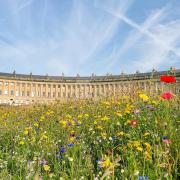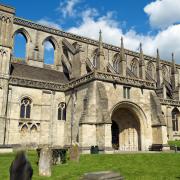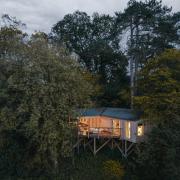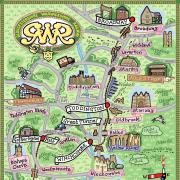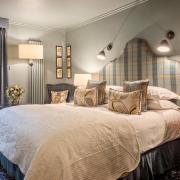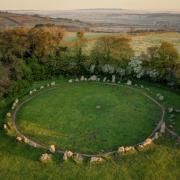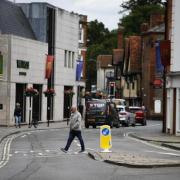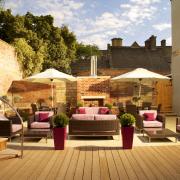Today Gustav Holst is best known as being the composer of what has been described as his ‘mesmerising masterwork’, the seven-movement orchestral suite, The Planets.’ And the place he is most associated with is his birthplace, Cheltenham.

He has certainly left his mark on his home town. There is the statue of him conducting in Imperial Gardens, and of course there is his birthplace museum at 4 Clarence Road. But there are many other hidden locations connected with him and his family in Cheltenham and beyond. And here is a selection of them…
CHELTENHAM

4 Clarence Road
Gustav Holst was born, and spent the first eight years of his life, here. Then known as 4 Pittville Terrace, his father, Adolph von Holst had moved here earlier in 1874. On September 21, 1974, exactly 100 years after Host’s birth it was announced that the birthplace was to be bought for the town by the borough council. It is now run by an independent trust.

All Saints Church, All Saints Road
This was the setting for Gustav’s parents wedding in 1871 and his father, Adolph, was organist and choirmaster here for 25 years. Gustav was baptised here, sang in the choir and played the violin and trombone in ensembles brought together for special occasions. It is also likely he composed his Four Voluntaries for Organ on this instrument.
Assembly Rooms, 130 High Street
Gustav’s father gave regular piano recitals here before and after Gustav was born. In December 1892 some selections of one of Gustav’s earliest compositions, a two-act operetta Lansdown Castle or The Sorcerer of Tewkesbury were performed here, conducted by Gustav as part of a Grand Orchestral Concert.
Cheltenham Cemetery, Bouncers Lane
Gustav’s father died suddenly on August 17, 1901, just a few weeks after Gustav had married his wife, Isobel Harrison. He was buried here on August 21 that year.
Corn Exchange, 173 High Street (Marks and Spencer now on site)
This is where Holst’s early two-act operetta Lansdown Castle was first performed in full in February 1893 in full by a ‘cast of amateurs’ with Gustav as piano accompanist. Holst was only 18 at the time. Even his father was impressed, and borrowed a hundred pounds from one of his relations and sent Gustav as a student to the Royal College of Music.

Dale, Forty & Co, 24 Promenade Villas
Situated opposite Neptune’s Fountain on the Promenade, Dale, Forty & Co. sold everything to do with music – instruments, gramophones and, later, radio. Co-founder, Frank Forty was a close friend of Gustav’s father who he referred to as ‘Old Von’. An enthusiastic amateur musician he sang bass in the All Saints Church choir. He was Gustav’s godfather, and was convinced he would become a successful composer and gave him every encouragement. Gustav dedicated his Phantastes Suite to him in 1911.

Cheltenham Grammar School, High Street
Holst started as a pupil here in the autumn of 1886. He was not happy, but nevertheless managed to do quite well academically. To his fellow pupils he was known as ‘Sausage’ for reasons now unknown. He was also able to display his musical talents at school, and appeared in a school concert on December 18, 1890 as a pianist, probably his first public appearance as a musician. Holst’s father taught music at the school.

Gustav Holst Memorial Fountain statue, Imperial Gardens
Created by sculptor Anthony Stones and cast at the Pangolin Foundry in Chalford, Holst is shown conducting with his left hand as he often did due to suffering from severe neuritis in his right hand. The statue was unveiled by conductor Sir Mark Elder on April 4, 2008.
Highbury Congregational Church, 3 Priory Walk
Holst’s father organised a performance of his son’s Duet for organ and trombone here on May 8, 1895 to celebrate Gustav being awarded during the preceding February a composition scholarship from the Royal College of Music, on his eighth attempt. His father played the organ, and a local musician played the trombone.

Cheltenham Ladies’ College, Bayshill Road
It was here on July 8, 1899 that one of the earliest performances of Gustav’s works took place. Pupils of Miss Sawyer and Lewis Hann included his Berceuse and Dance from a Suite in G minor in a recital.
46 Lansdown Crescent
An apartment here was the Holst family home from the Spring of 1891 and was given up on the death of Gustav’s father in 1901. This therefore would have been the home Gustav came back to when a student of the Royal College of Music. He would regularly save money by walking or cycling the 97 miles sometimes with his trombone slung on his back. Occasionally take the opportunity to practice the instrument while resting on the journey, to the surprise of farmers on whose land he sat.

Montpellier Rotunda
This was then a concert venue. Gustav’s father directed chamber orchestral concerts here in the 1860s and 1870s, and also gave regular concerts there as a piano soloist. Gustav was allowed to attend rehearsals and help with checking parts and cueing in missing instruments. In December 1891 the Rotunda was the scene of three premieres of works by the youthful composer. Also, in 1899 on May 13, he was back here when he appeared with ‘Herr Lortzing’s Ladies Choir’ ‘At Home’ and gave with his father the first performance of his Duet in D for two pianos.

3 Pittville Lawn
Then known as 2 Seagrave Place, this was the home of Mabel Forty, Gustav’s first girlfriend. She was one of three daughters of Frank Forty. There were also three brothers, one of whom died in infancy. It was to Mabel that he dedicated an Introduction and Bolero for piano duet and the manuscript contains the inscription “This was written expressly for and dedicated to My adored Beloved Sweet-Heart.” Then 18, her strong personality and lively sense of humour made her attractive to Holst. They often played piano duets together, including arrangements of Haydn symphonies. He visited her during his first vacation in Summer 1893.
Initially a pupil of local music teacher, Henry Rogers, a few years earlier, in 1890, she had taken part in what were billed as ‘All Saints Saturday Popular Concerts.’ These were arranged by her father, and the performers included family members and others from the church. She subsequently attended the Royal Manchester College of Music, for a while a pupil of Sir Charles Halle, graduating in around 1897. In that year she was awarded the Teachers’ Diploma with distinction in piano playing. She then became a music teacher in Manchester, moved to live with her brother in Birmingham sometime before the 2nd World War, and moved and died in a nursing home in Old Colwyn on the same day in 1944.

Town Hall
With Gustav’s fame in the 1920s some of Cheltenham’s leading citizens determined to mark this success and their initiative was to lead to two of the last appearances of Holst on a Cheltenham concert platform. The first, in 1927, was a celebration with two performances of his music in the Town Hall with Gustav himself conducting the City of Birmingham Symphony Orchestra his Planets suite. Such was the pleasure he gained from this mini-festival of his music and the plaudits of the town, that he returned to the Town Hall the following year to conduct the same orchestra in the British premiere of his new work Egdon Heath. And finally, in February 1930, he again returned to the Town Hall with the same orchestra to conduct the first concert performance of his choral ballet The Golden Goose and the premiere of his orchestral transcription of Fugue a la Gigue.
Winter Garden (then in Imperial Gardens)
Opened in 1878 this enormous building stretched from the back of where the Town Hall now is as far as the Queen’s Hotel, but predated the Town Hall by some 25 years. It was finally demolished between 1940 and 1943. It was here that on the afternoon of its opening Gustav’s father Adolph played Mendelssohn’s Piano Concerto op 40 with an orchestra ensemble, a sparkling work which would have been appropriate to the occasion and a good showpiece for the pianist.
AND BEYOND CHELTENHAM…

Bourton-on-the-Water and the Rissingtons
In 1892 at the tender age of 17, Holst was appointed organist and choirmaster of St Lawrence, Wyck Rissington, staying until May 1893. The organ he played is still in use today, bearing a commemorative plaque to Gustav presented by his many friends in the area. This appointment included with it the conductorship of a fifty strong choral society at nearby Bourton-on-the-Water. The salary was low (£4 pa at Wyck Rissington, nothing at Bourton) but it gave him valuable practical experience. He undertook the work with enthusiasm, even constructing the platform himself for his first concert. He arranged accompaniments for such instruments as were available locally and conducted performances of popular choral works, besides giving a few individual lessons on piano and organ. Although Bourton was then on the railway line, the Saturday service was restricted and there were no trains on Sunday. So, Holst had to stop over two nights before returning to Cheltenham on the Monday. He stayed with one of his singers, John Wilkins, whose brothers also sang in the choir. When returning to his lodgings in Bourton after the evening service in Wyck Rissington he would walk the two miles back across the fields in the dark, lighting his way with a lantern. Later in life he still remembered his friends in these villages and would often call in on Bourton-on-the-Water when visiting the Cotswolds.

Cirencester
Gustav’s mother, Clara Cox Lediard, was born here. She was one of his father’s pupils and was the fifth child of Mary Croft Lydiard and Samuel Lediard, a solicitor of Cirencester who allowed the recently married couple to live at 4 Pittville Terrace, a house they had in Cheltenham. Clara was herself a talented singer and pianist. In 1930 Gustav conducted a hymn festival in the parish church, one of many occasions he found time to help amateurs.

Cranham
Gustav’s mother’s family owned a cottage here and he named one of the tunes he composed for The English Hymnal Cranham (In the bleak midwinter) after this village. His mother played the harmonium in the local church before her wedding. A house in the village now known as The Buckholt, was originally Buckholt Cottage and as such was home to Gustav’s maternal great grandfather, David Whatley, whose daughter Mary was born in 1806. Mary married Samuel Lediard at the age of 20, and one of their nine children was Gustav’s mother, Clara. After her husband died suddenly of typhoid Mary had to look after the large family alone and lived with them at Buckholt Cottage for some years before moving to Pittville Terrace to enable her to send Clara to Cheltenham Ladies’ College and her son Henry to Cheltenham Collage. In Cranham itself there is a strong tradition, not founded in fact, that Holst actually composed In the bleak midwinter while staying in the village; a cottage there now bears the name Midwinter Cottage. The 35-mile Gustav Holst Way is a medium distance ramblers’ trail across the Cotswolds that was officially marked out in 2011. Beginning in Cranham, it makes its way past Holst’s birthplace before heading eastwards towards Wyck Rissington.
GLOUCESTER

Gloucester Cathedral, Westgate Street
Gloucester Cathedral was the setting for two Gustav Holst world premieres. In 1925, the Three Choirs Festival audience on September 9 witnessed the first ever public performance of his atmospheric motet, The Evening Watch, and a Festival audience six years later on September 8, 1931 were the first to hear his major work for choir organ and orchestra, the A Choral Fantasia premiere conducted by Holst himself.
7 Millers Green
Holst lodged here overnight with the Gloucester Cathedral organist, Herbert Sumsion, for a full rehearsal for the 1931 Three Choirs Festival in July. Herbert Sumsion had commissioned the work. To get there Holst travelled from London via Oxford and walked and bussed through the Cotswolds. After hours of travelling, he arrived at the Cathedral, battered and dishevelled and conducted the rehearsal in ill-fitting borrowed clothes. And the next day he conducted a full choral rehearsal after which he returned to London. He was back in Gloucester on September 5 for a busy week of rehearsals and concerts and on September 8 he directed the first performance of A Choral Fantasia with Dorothy Silk as soloist and Herbert Sumsion playing the organ part.
Shire Hall, Westgate Street
Then incorporating a 1,000-seater concert hall, this was the setting of a BBC broadcast of Holst’s Marching Song on September 11, 1925. It was performed by the London Symphony Orchestra under the direction of the Gloucester Cathedral organist and that year’s Three Choirs Festival director, Herbert Brewer. It was included in the second of the first two live broadcasts from the Festival.
The Gustav Holst & The Three Choirs Festival exhibition is at Holst Victorian House in Cheltenham until Saturday, June 1. holstvictorianhouse.org.uk








